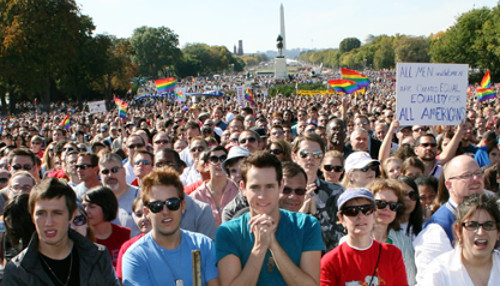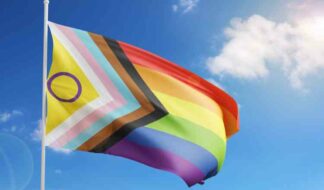BY LOU CHIBBARO JR., WASHINGTON BLADE

The last Equality March was held in 2009. Washington Blade file photo by Michael Key
As thousands descend on Washington, D.C. for the Equality March for Unity and Pride, it's important to remember that the LGBT community has quite a bit of experience executing national demonstrations. Here, we take a look back through the photographic archives of the Blade at five previous major LGBT demonstrations in D.C.

The 1979 National March on Washington for Lesbian and Gay Rights. Washington Blade archive photo by John M. Yanson
In what LGBT advocates and political observers considered an historic first, LGBT people from throughout the country came to the nation's capital on Oct. 14, 1979 for the nation's first National March on Washington for Lesbian and Gay Rights.
The idea of a gay march on Washington similar to the famous 1963 March on Washington for African-American rights initiated by Martin Luther King, Jr. had been pushed by San Francisco gay Supervisor Harvey Milk shortly before his assassination in 1978. New York gay activist Steve Ault and New York lesbian activist Joyce Hunter have been credited with moving Milk's plans forward.
Similar to the four LGBT Washington marches that followed in subsequent years, there were conflicting reports on the size of the turnout. The U.S. Park Police, which at the time gave crowd estimates for public events, initially estimated the turnout for the march to be 75,000 but later said between 25,000 and 50,000 people turned out.
Organizers of the march insisted that more than 100,000 people turned out.
Whatever the turnout, the event drew national media attention to the LGBT rights movement and, according LGBT advocates, motivated thousands of LGBT people to become active in the movement to secure their rights who were not involved before.
A five-point platform for the march called for passage by Congress of a "comprehensive" lesbian and gay civil rights bill; a presidential executive order banning discrimination based on sexual orientation in the federal workforce, the military, federally contracted private employers; repeal of all anti-gay/lesbian laws; an end to discrimination in child custody disputes for gay and lesbian parents; and protections for gay and lesbian youth against discrimination at home or in schools.
The march began near the Capitol and traveled along Pennsylvania Avenue to the White House before ending on the grounds of the Washington Monument, where a rally with speakers was held.

The 1987 National March on Washington for Lesbian and Gay Rights. Washington Blade archive photo by Doug Hinckle
Activists familiar with the Oct. 11, 1987 march say that while it called for some of the same LGBT rights advances as the 1979 march, it was prompted by two major developments – the widespread belief that the administration of President Ronald Reagan had failed to adequately respond to the AIDS epidemic and the 1986 U.S. Supreme Court decision upholding state sodomy laws, which made it a crime for consenting adults of the same gender to engage in sexual relations.
This time, U.S. Park Police estimated the turnout to be at least 200,000. Organizers declared the turnout to be well over 300,000, making the 1987 march and rally the largest LGBT demonstration ever held in the U.S.
Media coverage of the march and rally was heightened by the decision by creators of the AIDS Memorial Quilt to display the quilt for the first time on the National Mall on the same day as the march.
During the days following the march, some participants staged a civil disobedience demonstration on the steps of the Supreme Court to protest the sodomy law ruling that resulted in arrests.
Among the speakers at the march rally, which was held on the grounds of the U.S. Capitol, where gay U.S. Reps. Barney Frank and Gerry Studds, both Democrats from Massachusetts; former National Organization for Women president Eleanor Smeal; United Farm Workers Union president Cesar Chavez; and civil rights leader and then-presidential candidate Rev. Jesse Jackson.
Items added to the platform beyond those included for the 1979 march included a call for legal recognition of lesbian and gay relationships; repeal of sodomy laws applying to consenting adults; an end to discrimination against people with HIV/AIDS; reproductive freedom for women; and an end to racism in the U.S. and an end to apartheid in South Africa.

The 1993 March on Washington for Lesbian, Gay and Bi-Equal Rights and Liberation. Washington Blade archive photo by Doug Hinckle
Plans for the third march on Washington for "Lesbian, Gay, and Bi-Equal Rights and Liberation," as it was officially named, began prior to the 1992 presidential election while George H. W. Bush was president.
By the time the march took place on April 25, President Bill Clinton, who expressed support for gay rights during his election campaign, had been in office for just over two months. While march organizers were generally optimistic over a Clinton White House, some expressed concern that the new president appeared to be backing down from his promise to lift the ban on gays in the military following opposition to the proposal by many in Congress.
Thus a major theme of the 1993 march and its large rally at the site of the U.S. Capitol was the call to "lift the ban." Among those playing a visible role in the march were gay and lesbian veterans, some of whom wore their military uniforms.
Another vocal message delivered at the march was strong opposition to Colorado's Amendment 2, a ballot measure passed by voters that banned cities and counties in the state from adopting anti-discrimination laws protecting gays and lesbians.
AIDS activists and members of the AIDS protest group ACT UP also emerged as highly visible participants in the march, which traveled from the White House to the Capitol.
By 5 p.m., hours after the march began, marchers could be seen at the far end of the National Mall near the Washington Monument still streaming onto the Mall, which appeared to be completely filled with people involved in the march. This prompted organizers to declare they had reached their goal of drawing a turnout of a million people. As with the previous two gay marches, U.S. Park Police issued a significantly lower figure, putting the turnout at 300,000.
Some participants expressed disappointment that Clinton declined an invitation to speak at the rally and also didn't agree to record a video message to be shown at the rally. Instead, he sent a written message to be read at the rally expressing strong support for LGBT rights and increased funds for the fight against AIDS.
Then-D.C. Mayor Sharon Pratt Kelly, then-New York City Mayor David Dinkins, and U.S. Sen. Paul Wellstone (D-Minn.), were among the speakers at the rally.

Students attend the Millennium March for Equality. Photo courtesy of Michael Key
Held on April 30, 2000, the fourth national LGBT march on Washington, named the Millennium March on Washington for Equality, drew hundreds of thousands of LGBT people and their supporters despite a rocky start that sparked strong divisions among LGBT activists.
In a break from the first three 'gay' Washington marches, which were initiated by individual activists, the Millennium March was initiated by the Human Rights Campaign, the nation's largest LGBT civil rights group, and the Rev. Troy Perry, leader of the Universal Fellowship of Metropolitan Community Churches.
Rather than seek input from grassroots activists and local LGBT groups, HRC and Perry formed a march committee on their own and hired lesbian comedian and events producer Robin Tyler, who had been calling for another gay march, as the march's executive producer. In a press release announcing the march, the committee boasted that corporate sponsors were being lined up to help finance the march and a long list of celebrities, most of whom were gay or lesbian, would be performing at a concert during the weekend of the planned march.
Infuriated over what they called a top down, undemocratic structure, many LGBT activists denounced the proposed march and vowed to organize a boycott. But as criticism mounted, HRC and Perry agreed to make changes to broaden the organizing committee and vowed to make the march the most diverse LGBT event ever held. Transgender activists and LGBT people of color were brought into leadership positions.
With the November 2000 presidential election approaching, many LGBT activists agreed a national LGBT march would be an important showing of LGBT political clout. Similar to the 1993 march, the National Mall appeared filled with march participants on April 20, 2000, prompting organizers and many observers to estimate the turnout to be 800,000. A short time before the Millennial March was held, U.S. Park Police discontinued making crowd estimates for events on the Mall.
Meanwhile, this time President Clinton and Vice President Al Gore, who was running for president, spoke to the crowd through a large video screen on the Mall near the Capitol, where the rally was held.
An array of entertainers and celebrities, including Melissa Etheridge, Martina Navratilova, and actress Anne Heche, appeared on the stage at the rally. On the evening before the march, an HRC-produced concert at D.C.'s RFK Stadium called Equality Rocks, drew a sold-out crowd, which saw performances by Etheridge, George Michael, Pet Shop Boys, and k.d. Lang.
All of this drew extensive media coverage that for the most part omitted any mention of the internal LGBT strife surrounding the march and portrayed the event as a successful demonstration for LGBT equality.

The last LGBT march on Washington was the National Equality March on Oct. 11, 2009. Washington Blade file photo by Michael Key
Held on Oct. 11, 2009 on National Coming Out Day, the National Equality March is believed to have attracted about 150,000 people to Washington on a relatively short notice.
Longtime gay rights advocate David Mixner is credited with initiating the march in an effort to build on the groundswell of LGBT activism on social media generated by the approval by California voters of Proposition 8, a ballot measure that overturned the state's same-sex marriage law.
San Francisco gay rights leader Cleve Jones, founder of the Names Project that created the AIDS Memorial Quilt, became involved as one of the lead organizers along with lesbian activist Robin McGehee and gay activist Kip Williams.
Similar to the previous LGBT Washington marches, the 2009 march traveled from the White House to the U.S. Capitol, where about two-dozen speakers, including mainline civil rights leaders, LGBT leaders, and supportive elected officials spoke in support of marriage equality, a federal LGBT non-discrimination bill, and repealing the military's 'Don't Ask, Don't Tell' policy.
The march took place during President Barack Obama's first year in office, and some of the march speakers expressed concern that he wasn't moving fast enough on his campaign promises to back LGBT rights legislation.
Among those who spoke and performed at the rally was bisexual singer and LGBT rights supporter Lady Gaga.
Unlike the previous LGBT Washington marches, that mainly closed their books in debt, the 2009 march generated a surplus in funds that organizers gave to existing grassroots LGBT rights organizations.
Among the key goals of march organizers was to put in place a network of grassroots LGBT organizers in each of the nation's 435 congressional districts to push for LGBT equality under the auspices of a new group called Equality Across America. But activists familiar with the group acknowledge that goal was never reached and the group is no longer active.










